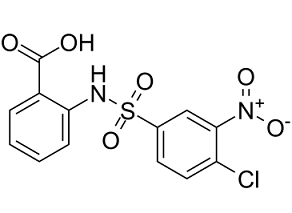
| 规格 | 价格 | 库存 | 数量 |
|---|---|---|---|
| 100mg |
|
||
| 250mg |
|
||
| 500mg |
|
||
| 1g |
|
||
| Other Sizes |
| 体内研究 (In Vivo) |
特定的糖酵解调节剂 CTPI-2 限制癌症干细胞 (CSC) 的代谢适应性。腹腔注射 CTPI-2 (26 mg/kg) 可抑制非小细胞肺癌 (NSCLC) 体内模型肿瘤生长 [1]。在一项预防研究中,CTPI-2(50 mg/kg;腹腔注射;每隔一天,持续 12 周)完全避免了体重增加,而在一项逆转研究中,它显着减轻了体重 [2]。 ?CTPI-2恢复正常的糖耐量并避免脂肪性肝炎。除了增强抗炎 IL-4 和 IL-10 之外,CTPI-2 还能降低 IL-6 的循环水平,并减少干扰素 γ 诱导的单核细胞趋化蛋白 1 和吸引中性粒细胞和单核细胞的单核因子。柠檬酸库、脂肪生成和糖异生途径均受 CTPI-2 调节 [2]。
|
|---|---|
| 动物实验 |
Animal/Disease Models: C57BL/6J mice (HFD-fed mice) [2]
Doses: 50 mg/kg Route of Administration: Via intraperitonealroute on alternate days for 12 weeks Experimental Results: Complete avoidance of weight gain in prevention study, and resulted in significant weight loss regression studies. |
| 参考文献 |
|
| 分子式 |
C13H11N2O6SCL
|
|---|---|
| 分子量 |
358.75424
|
| 精确质量 |
355.987
|
| CAS号 |
68003-38-3
|
| 相关CAS号 |
68003-38-3;
|
| PubChem CID |
106350
|
| 外观&性状 |
Off-white to light yellow solid powder
|
| 密度 |
1.66g/cm3
|
| 沸点 |
564.8ºC at 760 mmHg
|
| 闪点 |
295.4ºC
|
| 折射率 |
1.678
|
| LogP |
4.424
|
| tPSA |
137.67
|
| 氢键供体(HBD)数目 |
2
|
| 氢键受体(HBA)数目 |
7
|
| 可旋转键数目(RBC) |
4
|
| 重原子数目 |
23
|
| 分子复杂度/Complexity |
558
|
| 定义原子立体中心数目 |
0
|
| InChi Key |
NJTHPOSQGFJTDP-UHFFFAOYSA-N
|
| InChi Code |
InChI=1S/C13H9ClN2O6S/c14-10-6-5-8(7-12(10)16(19)20)23(21,22)15-11-4-2-1-3-9(11)13(17)18/h1-7,15H,(H,17,18)
|
| 化学名 |
2-[(4-chloro-3-nitrophenyl)sulfonylamino]benzoic acid
|
| HS Tariff Code |
2934.99.9001
|
| 存储方式 |
Powder -20°C 3 years 4°C 2 years In solvent -80°C 6 months -20°C 1 month |
| 运输条件 |
Room temperature (This product is stable at ambient temperature for a few days during ordinary shipping and time spent in Customs)
|
| 溶解度 (体外实验) |
DMSO : ~125 mg/mL (~350.40 mM)
|
|---|---|
| 溶解度 (体内实验) |
配方 1 中的溶解度: ≥ 2.08 mg/mL (5.83 mM) (饱和度未知) in 10% DMSO + 40% PEG300 + 5% Tween80 + 45% Saline (这些助溶剂从左到右依次添加,逐一添加), 澄清溶液。
例如,若需制备1 mL的工作液,可将100 μL 20.8 mg/mL澄清DMSO储备液加入400 μL PEG300中,混匀;然后向上述溶液中加入50 μL Tween-80,混匀;加入450 μL生理盐水定容至1 mL。 *生理盐水的制备:将 0.9 g 氯化钠溶解在 100 mL ddH₂O中,得到澄清溶液。 配方 2 中的溶解度: ≥ 2.08 mg/mL (5.83 mM) (饱和度未知) in 10% DMSO + 90% (20% SBE-β-CD in Saline) (这些助溶剂从左到右依次添加,逐一添加), 澄清溶液。 例如,若需制备1 mL的工作液,可将 100 μL 20.8 mg/mL澄清DMSO储备液加入900 μL 20% SBE-β-CD生理盐水溶液中,混匀。 *20% SBE-β-CD 生理盐水溶液的制备(4°C,1 周):将 2 g SBE-β-CD 溶解于 10 mL 生理盐水中,得到澄清溶液。 View More
配方 3 中的溶解度: ≥ 2.08 mg/mL (5.83 mM) (饱和度未知) in 10% DMSO + 90% Corn Oil (这些助溶剂从左到右依次添加,逐一添加), 澄清溶液。 1、请先配制澄清的储备液(如:用DMSO配置50 或 100 mg/mL母液(储备液)); 2、取适量母液,按从左到右的顺序依次添加助溶剂,澄清后再加入下一助溶剂。以 下列配方为例说明 (注意此配方只用于说明,并不一定代表此产品 的实际溶解配方): 10% DMSO → 40% PEG300 → 5% Tween-80 → 45% ddH2O (或 saline); 假设最终工作液的体积为 1 mL, 浓度为5 mg/mL: 取 100 μL 50 mg/mL 的澄清 DMSO 储备液加到 400 μL PEG300 中,混合均匀/澄清;向上述体系中加入50 μL Tween-80,混合均匀/澄清;然后继续加入450 μL ddH2O (或 saline)定容至 1 mL; 3、溶剂前显示的百分比是指该溶剂在最终溶液/工作液中的体积所占比例; 4、 如产品在配制过程中出现沉淀/析出,可通过加热(≤50℃)或超声的方式助溶; 5、为保证最佳实验结果,工作液请现配现用! 6、如不确定怎么将母液配置成体内动物实验的工作液,请查看说明书或联系我们; 7、 以上所有助溶剂都可在 Invivochem.cn网站购买。 |
| 制备储备液 | 1 mg | 5 mg | 10 mg | |
| 1 mM | 2.7875 mL | 13.9373 mL | 27.8746 mL | |
| 5 mM | 0.5575 mL | 2.7875 mL | 5.5749 mL | |
| 10 mM | 0.2787 mL | 1.3937 mL | 2.7875 mL |
1、根据实验需要选择合适的溶剂配制储备液 (母液):对于大多数产品,InvivoChem推荐用DMSO配置母液 (比如:5、10、20mM或者10、20、50 mg/mL浓度),个别水溶性高的产品可直接溶于水。产品在DMSO 、水或其他溶剂中的具体溶解度详见上”溶解度 (体外)”部分;
2、如果您找不到您想要的溶解度信息,或者很难将产品溶解在溶液中,请联系我们;
3、建议使用下列计算器进行相关计算(摩尔浓度计算器、稀释计算器、分子量计算器、重组计算器等);
4、母液配好之后,将其分装到常规用量,并储存在-20°C或-80°C,尽量减少反复冻融循环。
计算结果:
工作液浓度: mg/mL;
DMSO母液配制方法: mg 药物溶于 μL DMSO溶液(母液浓度 mg/mL)。如该浓度超过该批次药物DMSO溶解度,请首先与我们联系。
体内配方配制方法:取 μL DMSO母液,加入 μL PEG300,混匀澄清后加入μL Tween 80,混匀澄清后加入 μL ddH2O,混匀澄清。
(1) 请确保溶液澄清之后,再加入下一种溶剂 (助溶剂) 。可利用涡旋、超声或水浴加热等方法助溶;
(2) 一定要按顺序加入溶剂 (助溶剂) 。
|
|
|